May 15, 2025 | 05:45 GMT +7
May 15, 2025 | 05:45 GMT +7
Hotline: 0913.378.918
May 15, 2025 | 05:45 GMT +7
Hotline: 0913.378.918
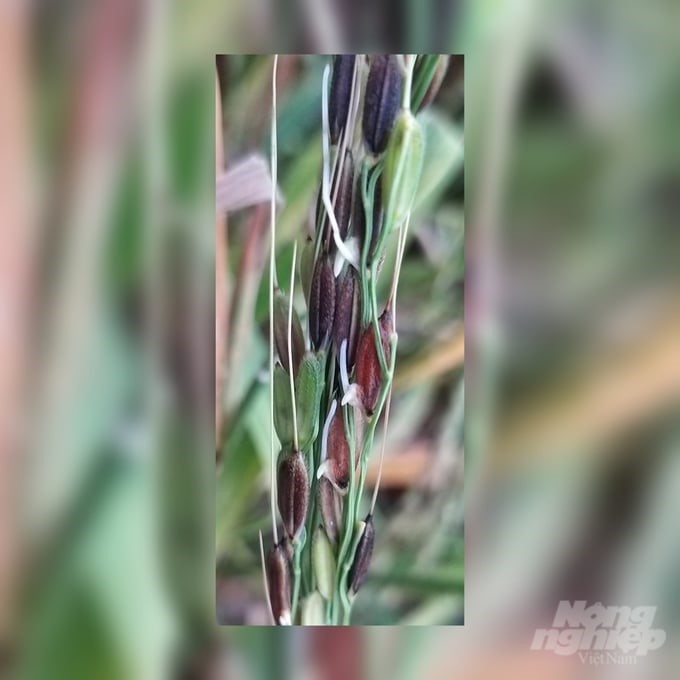
Weedy rice grains do not have dormancy. Photo: DVC.
Recently, a number of journalists have written articles about wild rice and weedy rice and published them in the mass media. This is a good condition for the Vietnamese social community to have multi-dimensional, formal, and critical discussions to find a correct common perception about the potential risks of a newly emerging pest that can affect rice, Vietnam's important commodity industry in both the present and the future.
A question is whether, in the upcoming 5–6 years, Vietnamese scientists and interested people need to prepare to build a long-term program in 15 years (2030–2045) on "Current situation and risks of weedy rice affecting rice production and trading in Vietnam." Through this program, it will be possible to conclude whether weedy rice deserves attention for prevention and treatment to protect Vietnam's rice production.
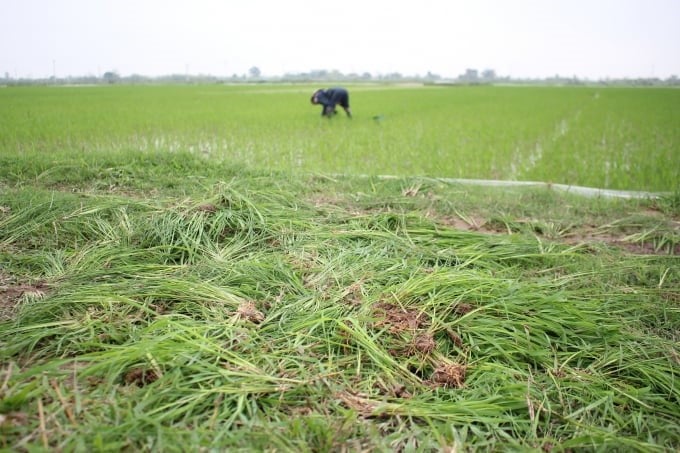
In the North, weedy rice is increasingly growing strongly. Photo: Trung Quan.
Wild rice
Wild rice, also called "ghost rice" by Vietnamese farmers, includes plants of different species belonging to the same genus as cultivated rice (Oryza). They can be perennial or annual plants.
In the world, there are many different species of wild rice, but in Vietnam, there are two perennial species of wild rice, O. rufipogon and O. glaberima, and one annual species, O. nivara.
If they are perennial plants, they can reproduce both sexually and asexually. When perennial plants establish populations from grains, the plants only grow nutritionally in the first year; flower and produce grains in the second year; and flower and produce grains annually from the third year onwards. If they are annual plants, they can only reproduce sexually, not asexually.
Wild rice species mainly live in wild swamps and along rivers and canals. However, in some cases, they also intrude on fields and cause damage to economic crops. Wild rice is photosensitive, only blooming once a year when the day is short. Wild rice grains are also harvested, milled, and eaten as food. Wild rice living in the wild is not called weeds. Only when wild rice intrudes and causes harm to the crop is it called weeds.
Weedy rice
Weedy rice means plants belonging to the genus Oryza, mixed rice, and lines mutated, degenerated, or separated from hybrids that have been purebred or are still segregating, which infest and cause harm in cultivated rice fields. The word "weedy rice" was only widely used in the world in the late 20th and early 21st centuries. Before that, this plant population was called "red rice."
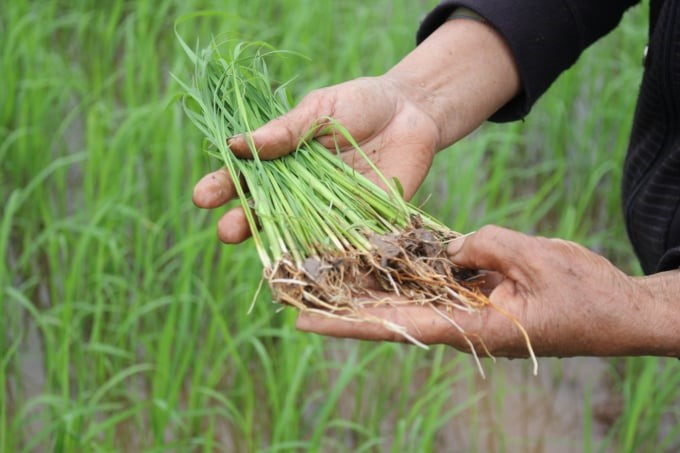
Weedy rice makes farmers spend a lot of time uprooting it. Photo: Trung Quan.
The word "red rice" is commonly used in scientific documents as well as in mass media because it is related to the economic benefits of rice production. White rice mixed with red rice grains pulled the price down and reduced profits, which was unexpected for people. Today, this problem is no longer important because there are color separators that can remove red rice grains and other discolored grains from batches of white rice grains.
Through the process of evolution, most rice lines available in the world today produce white rice grains. That is why the name "weedy rice" is commonly used today. Weedy rice includes both wild rice and hybrid lines between cultivated rice and wild rice, as well as variations of cultivated rice.
In Africa, the main cultivated rice species is O. glaberrima. Wild rice species such as O. barthii, O. longistaminata, and O. punctata that invade cultivated rice fields to cause damage are considered weedy rice. On other continents, weedy rice is mainly hybrid lines between cultivated rice (O. sativa) and wild rice and variations of cultivated rice.
The basic characteristics of most of the remaining weedy rice lines in the world are: they have the same scientific name as cultivated rice (O. sativa), but they have weedy genetic characteristics, such as being taller than cultivated rice, blooming early, having a dark yellow, brown, or black husk, having a short or long awn, being easy to fall off when it is about to ripen, and having red or white rice grains.
Cultivated rice
Cultivated rice can be traditional local varieties that are photosensitive and grown with only one crop per year, or short-term high-yielding varieties that are not photosensitive and are grown with many crops per year. Cultivated rice in Africa is the O. glaberrima species, while cultivated rice on other continents is O. sativa.

Farmers keep the field surface moist after the rice harvest crop to create conditions for weedy rice to sprout and destroy.
Weedy rice also originates from mutations, hybridization, and degeneration in cultivated rice varieties. In the weedy rice population in the field, most of the lines are purebred (homozygous), and only a small proportion are still segregating (heterozygous).
Weedy rice in the Americas originates mainly from rice seeds mixed with red rice imported from India. In Asia and Africa, the origin of weedy rice is different from that in America and Europe because Asia is the location for rice cultivation and domestication of O. sativa rice species, and Africa is for O. glaberiima. These two places have had a tradition of growing rice for thousands of years.
Weddy rice also originates from cross-breeding between cultivated rice and wild rice. Annual or perennial wild rice can cross-breed with cultivated rice if they flower at the same time as each other. The rate of hybridization is about 1–2%. Gene flow is mainly in the direction from cultivated rice (O. sativa) to wild rice.
Pollen grains from the male stamen of O. sativa fly to pollinate and fertilize the female pistil of wild rice species. O. rufipogon, O. nivara, some other Oryza species, and purebred or segregating weedy rice lines in the field all share the same AA genome, with 12 pairs of chromosomes that can crossbreed with cultivated rice, Oryza sativa (Sitch, 1990).
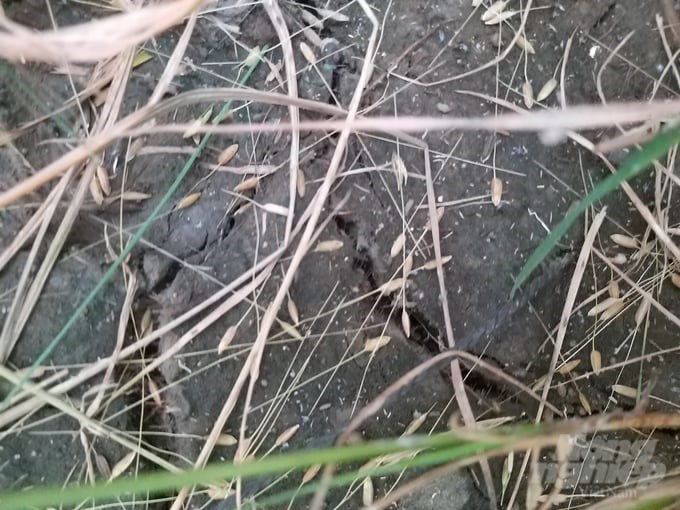
Weedy rice grains grow in the fields. Photo: DVC.
Weedy rice causes a reduction in the productivity and quality of commercial rice, an increase in production costs, and a decrease in profits.
In the State of Arkansas, America, on the Wells rice variety, rice productivity decreased by 35% when the field was infested with 22 weedy rice plants/m2. With 0.6 million hectares in Arkansas, the loss was USD 200/ha. Every year, the economic loss is USD 78 million. In the Rhone Delta in southern France, on an area of 20,000 hectares, rice productivity decreased by up to 50% due to weedy rice.
The world's rice-growing area infested with weedy rice is increasing. In Thailand, 2 million hectares of rice infected with weedy rice have been reported. In Asian countries such as Malaysia, Sri Lanka, Thailand, India, Korea, the Philippines, and Vietnam, damage due to weedy rice varies from 5 to 86%. The expanding infestation of weedy rice in these countries is closely related to the transition from transplanted rice to direct-seeded rice.
A study at the Cuu Long Delta Rice Research Institute conducted in Can Tho and Tien Giang came to the conclusion that the population density of grassy rice of 12.2 cloves/m2 (equivalent to 24.6 grams of dry matter/m2) reduces productivity by 10.6%. When the density of weedy rice increased to 454.9 cloves/m2 (552 grams/m2), the yield of cultivated rice was only 1/6 compared to the independent variable of weedy rice cleanliness (Chin et al., 1999).
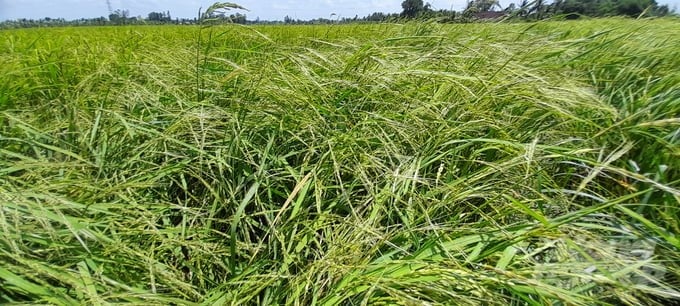
Rice fields are heavily infected with weedy rice in Thoi Lai district, Can Tho city. Photo: DVC.
Rice-growing areas with a high risk of weedy rice infection need to be delimited, identified, and evaluated accurately to have appropriate management measures. Besides upland rice, some popular types of wet rice cultivation in Vietnam are transplanted rice, wet-seeded rice, dry-seeded rice, direct-seeded rice, and underground-seeded rice.
Transplanted rice is popular in Northern Vietnam; however, currently, the area of sown rice is increasing and gradually replacing the area of transplanted rice. Rice sowing is popular in the South. Of which, weedy rice is the most abundant in dry sowing form when farmers plow the soil during the dry season and spread seeds on the field surface when the rainy season is about to begin. In the open water areas of the Long An and Ca Mau peninsulas, there are still some areas where dry sowing techniques are applied.
Direct sowing has the second-highest level of weedy rice infection. After harvesting the winter-spring rice, the straw is burned, water is pumped into the field, and the germinated seeds are sown on the moist ash layer.
Underground-seeded rice is sown under flooded conditions, and the level of weedy rice infestation is also low. Wet sowing is a popular technique, and weedy rice appears at a medium level. In the South, rice monoculture and direct sowing are common, so weedy rice has a higher chance of infestation and spread. Meanwhile, the North has a cold winter season when winter vegetable crops (corn, soybeans, vegetables, etc.) are grown instead of growing rice, and in that case, weedy rice grains growing in upland crop fields are easily killed by specialized herbicides for crops, helping to treat weedy rice grains for the next rice crop.
Using clean weedy rice seeds
It is recommended to use officially certified seeds that are not mixed with weedy rice grains. Farmers should buy certified seeds that are produced and sold by reputable companies because these seeds are not mixed with weedy rice grains. If farmers use commodity rice as seed for the next crop, the weedy rice grains in the commodity rice will be planted in the field and form a weedy rice population that competes with cultivated rice while increasing the weedy rice grain fund in the soil over time.
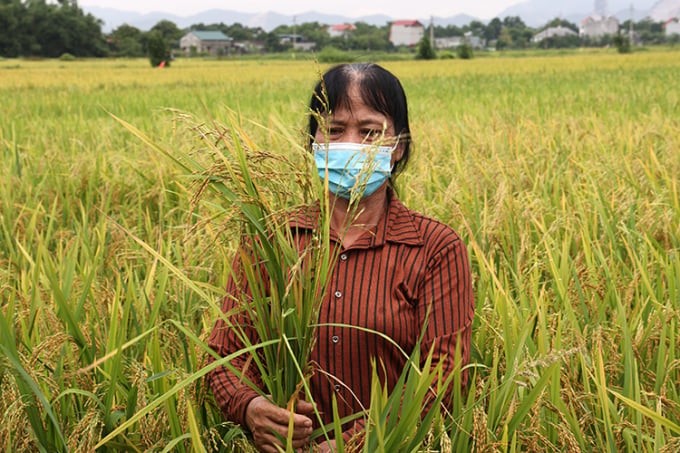
Weedy rice costs farmers a lot of effort to remove from the fields, reducing rice productivity.
Using water to prevent weedy rice
Wet-seeded rice is gradually becoming popular in many rice-growing countries around the world. After the young seedlings are established in the field, water is pumped into the field at a level of about 5cm to prevent weedy rice grains and other weeds from germinating, sprouting, and growing into plants that compete with cultivated rice. Always keep 5–10 cm of water in the field until the rice reaches the canopy, about 15–20 days after sowing.
Minimizing the weedy rice grain fund in the soil
The more weedy rice grain in the soil, the larger the population of weedy rice that grows, negatively affecting the productivity and quality of cultivated rice. Depending on each specific situation, feasible measures must be taken to reduce the weedy rice grain fund in the soil.
After harvesting a rice crop, it is necessary to create optimal moisture conditions for weedy rice grains lying on the ground to germinate and grow into plants. If water floods the field, pump it out until it dries up, keeping just enough moisture for the grain to germinate. When the field surface is too dry, inject irrigation to just moisten the ground enough for the grain's germination needs.
When the grains have grown into plants, mechanically plow the soil to kill young weedy rice plants. After the first phase of plowing, when the weedy rice grains deep in the soil have the opportunity to move closer to the ground, create optimal moisture conditions for this batch of weedy rice grains to grow into plants for further plowing and killing.
Before each crop, this process should be implemented a few times to help reduce the weedy rice grain fund in the soil. The sequence of these technical steps is also appropriate and does not conflict with the tillage process to prepare for the next crop. It is necessary to take advantage of reducing the recommended amount of fertilizer by 50% and burying it deep when plowing the soil to kill weedy rice to save costs but not reduce rice productivity.

Field-running ducks will help effectively remove weedy rice grains from the fields.
Duck flocks running in the fields
In the Mekong Delta, there are many farmers raising field-running duck flocks to produce duck eggs. They move ducks from one field to another to find food for the ducks in the fields, including weedy rice grains and rice grains that fall on the field surface after harvest. Farmers have to pay fees to the field owner when releasing ducks to eat in the field.
Fontenote's research (1973) on the duck's digestive system concluded that grains of weedy rice and cultivated rice (Oryza sativa), after being eaten by ducks, were crushed and killed by the gizzard in the duck's digestive system. This opens up the prospect of using runner ducks to collect weedy rice grains in the field, contributing to reducing the weedy rice grain fund in the soil.
Eliminating weedy rice plants in rice fields
The scattered sowing by wet sowing method is gradually becoming popular around the world. At the nutritional growth stage, farmers cannot distinguish between weedy rice and cultivated rice plants in the fields to uproot them. Therefore, this method should be replaced by row sowing or cluster sowing.
Rice plants growing between rows or clusters have a high probability of being weedy rice plants that can be distinguished and removed early. Weedy rice blooms earlier, which can be used to distinguish and eliminate weedy rice plants. It is not recommended to cut the roots with a sickle, but to use a knife to uproot the entire root system of the weedy rice plant, bring it to the field to dry at the root, and burn it thoroughly.
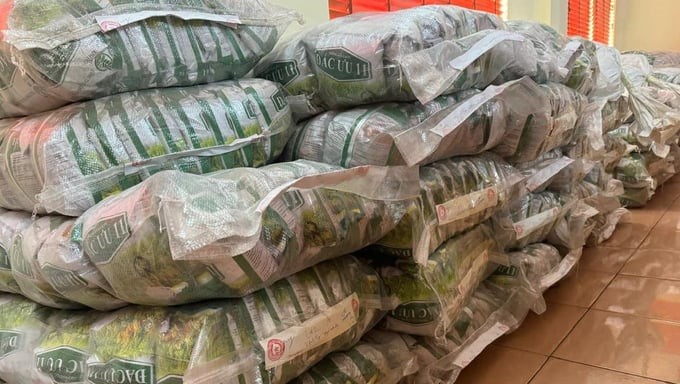
It is necessary to use certified rice seeds that are not mixed with weedy rice grains.
Changing the method of establishing crops
In fields where sowing techniques have been applied for many years, the infestation of weedy rice has become heavy, so the seeded rice has been changed to transplanted rice. This is an effective measure to reduce the growth of weedy rice. In Italy, during the 1920–1960 period, seeded rice was replaced by transplanted rice, and the infestation of weedy rice was significantly reduced. Meanwhile, in Malaysia, in the 1980s, transplanted rice was converted to seeded rice, leading to an increasingly serious infestation of weedy rice.
Crop rotation
Rice fields heavily infested with weedy rice can be converted to other upland crops, such as vegetables, to help reduce weedy rice. When cultivating upland crops, the field is only kept moist without flooding, creating favorable conditions for weedy rice grains to germinate and grow into weedy rice plants in the crop field. In this situation, weedy rice is just a plant belonging to the family Poaceae that is readily infected and killed by specific herbicide chemicals used on crops.
Strategies for biotechnology and herbicide-resistant rice varieties
In the world, there are biotechnology advances that can be applied to contribute to the management of weedy rice. One of those contents is to create herbicide-resistant rice varieties. In the early years of the 21st century, the Cuu Long Delta Rice Research Institute had a cooperation program with BASF Group (Germany) to implement these contents.
BASF has a rice variety carrying the Imidazolinone herbicide-resistant gene discovered by Louisiana University. Scientists at the University of Louisiana created a mutation to create this rice variety. Commercial rice varieties were transferred to the Cuu Long Delta Rice Research Institute. Breeding geneticists at the Institute have cross-bred with a number of high-quality rice varieties in Vietnam and selected over many generations for many years. The result was to create two rice varieties, OMCF6 and OMCF9, that were purebred and contained the herbicide-resistant gene.
Currently, these two varieties are being stored in the Institute's gene fund. When planting OMCF6 and OMCF9 varieties in the field and spraying herbicides of the Imidazolinone group, weedy rice and other weeds are killed because they do not have medicine-resistant genes.
Therefore, a question is whether scientists at the Cuu Long Delta Rice Research Institute and other institutes and schools in Vietnam should continue to research this program. OMCF6 and OMCF9 varieties should be used to cross-breed with other varieties to produce a series of new rice varieties to serve the weedy rice management program in the future. When successful, these rice varieties should be monopolized by the state's management rights to serve national target programs.
Because if left to private businesses, they will chase profits to produce tens of thousands of tons of seeds to serve millions of hectares, leading to the risk of appearing new weedy rice lines resistant to the Imidazolinone herbicide, ruining the research program that has been invested with money and effort in advance.
Translated by Thu Huyen
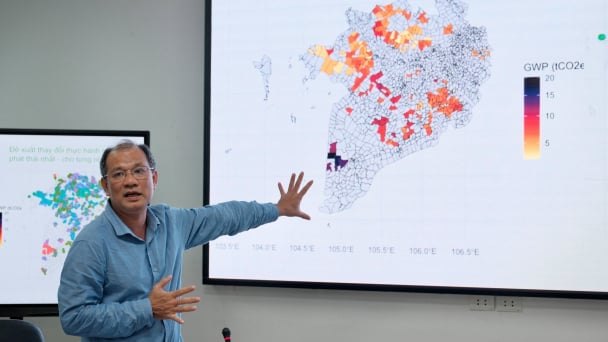
(VAN) Data from 10,000 farming households will help professionalize production organization and support the implementation of the One Million Hectares Program for High-Quality, Low-Emission Rice Cultivation.
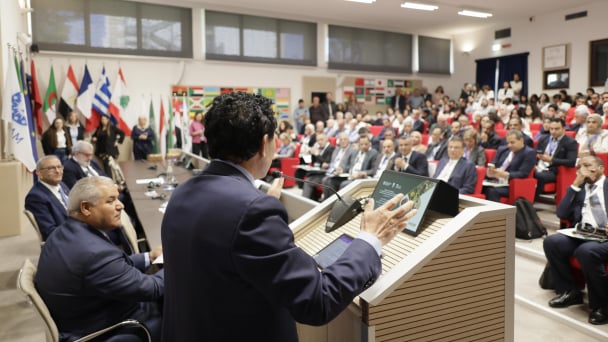
(VAN) FAO Director-General QU Dongyu marks International Day of Plant Health at NENA conference.
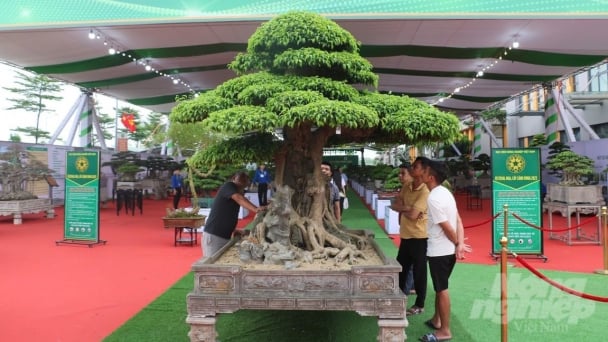
(VAN) Deputy Minister of Agriculture and Environment Hoang Trung affirmed that floriculture and ornamental plants are a growing industry that receives significant global attention.

(VAN) The three staple crops dominating modern diets – corn, rice and wheat – are familiar to Americans. However, fourth place is held by a dark horse: cassava.
/2025/05/10/4037-3-223011_495.jpg)
(VAN) Remote sensing technology is becoming an indispensable tool in monitoring resources, developing modern agriculture, and protecting the environment in Vietnam.

(VAN) The trash bag used on fishing vessels can withstand rough sea conditions, including level 8 to level 10 winds and waves. Notably, it can be hung anywhere on the boat.

(VAN) African leaders launched the Kampala Declaration on Building Resilient and Sustainable Agrifood Systems in Africa, marking a bold step toward transforming the continent's agriculture.